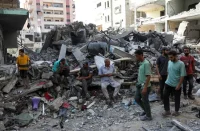The Arab Spring has finally become beastly, marching stealthily and devouring a third dictator in the Middle East when it all but seemed that the region was lapsing back to its bad old ways of autocratic rule.
In the event, President Ali Abdullah Saleh’s exit turned out to be even more dramatic than that of the Tunisian and Egyptian dictators. He was attacked while actually praying in a mosque in Sanaa on Friday and he thought he suffered mild burns but without his consenta flying wood shrapnel inserted itself and got lodged somewhere close to his heart. All God’s will.
Saleh promptly evacuated himself with his family to Saudi Arabia to undergo surgery. The key figures in his regime are frantically trying to flee the country. Clearly, the curtains are coming down. One can almost see the cows grazing on the window curtains in the dictator’s palace in Gabriel Marquez’s novel Autumn of the Patriarch. The Yemeni revolution is actually more like slow motion black and white talkie.
Great uncertainties arise. The 24 million people of Yemen possess an estimated 60 million guns. The military is split, with one section siding with the opposition while the elite military units remained loyal to Saleh. The opposition is also split between the original opposition comprised of Tahir-Square like demonstrators of youth and the middle class and professionals who genuinely clamoured for regime change and for the freedom and a better future they imagined would come with it, and a more recent, new opposition born out of a realigned grouping of ancient tribal chieftains who calculated for a variety for tactical reasons that Saleh should go.
Then, the Houthi tribes of the north and the Yemenis in the south are seeking autonomy. In the south, in particular, which harbours a deep sense of discrimination, the struggle is for outright secession, which Sanaa cannot tolerate since the country gets 70% of its income from oil exports and 80% of it comes from the south. Saleh was clever, he played the tribes off one another.
Not surprisingly, the Islamists are the best organised force in the fragmented nation, including in the south which used to be a Marxist state before the ‘unification’ in 1990 precipitated by the fall of the Soviet Union. America calls them al-Qaeda but many interpretations become possible with regard to political Islam. Yemen, of course, was Osama bin Laden’s ‘native’ country – in a manner of speaking for a world citizen.
There could be a civil war in Yemen in the ensuing struggle for power, a fragmentation of the country or even a descent into Somalia-type anarchy. What compounds the situation is that there is also large-scale foreign interference. In the name of ‘orderly’ transfer of power and a ‘democratic’ transition, United States is working behind the scenes in tandem with Saudi Arabia. The ‘al-Qaeda problem’ becomes ostensibly the reason for the interference, but the matrix is far more complex than a straightforward case of war on terror.
Like Afghanistan and Pakistan, Yemen also has been cursed by a unique geography and any power that establishes a pre-eminence on that land can aspire to exercise influence over the neighbouring regions… And the regions surrounding Yemen happen to be highly strategic: it is a gateway to the Mediterranean and the Indian Ocean, it borders Saudi Arabia and it is a vantage point overlooking east Africa and it is part of the strategically important oil-rich Persian Gulf region which, of course, includes another Shi’ite country like it, Iran.
Again, like Iraq, Yemen is cursed by nature as it contains oil although no one knows yet how much reserves it possesses, or at least, those who know do not want to tell. Quite obviously, US would dearly wish to get a military presence established in Yemen, whatever be the pretext needed for it.
For Saudi Arabia, too, Yemen is of high strategic importance. Historically, the tribes co-existed and intermingled without caring for today’s national borders. Yemen borders Saudi Arabia and there is also adormant border dispute between the two countries. The Houthis of the north pose a worrisome problem for the Saudis as they share a common border and Saudi Arabia’s eastern Shi’ite provinces, which are oil-rich, also happen to be politically restive.
The spectre that haunts Saudi Arabia is undoubtedly the alchemy of the Shi’ite empowerment in Yemen. The Shi’ite majority in Bahrain is also seeking empowerment and Riyadh is sensitive about the reverberations of all this on its own Shi’ite community that accounts for 15 to 18 percent of its population. Besides, the Saudis are aghast that the virus of democratisation has come to their doorstep finally in the Persian Gulf and the genie has got out of the bottle.
The former US Secretary of State Henry Kissinger bluntly warned at a weekend roundtable in Berlin that all this business of democracy is turning out to be rather pernicious for American interests. Kissinger admitted that the upheaval in the Persian Gulf region poses a “strategic and at the same time moral problem” for the US, but all the same, it’s not “in our interests”, he maintained, for Shi’ites to take over power since that could lead to the “break-up of Saudi Arabia”.
At the root of it all lies the fear that the flag carriers of democratisation may turn out to be a Lebanon-like Hezbollah. The Yemeni Islamists also have strong grassroots presence and they also operate as neighbourhood groups. They have a strong organisational structure and disciplined cadres. This was the reason why the former Egyptian dictator Hosni Mubarak was determined to ensure that Saleh stayed in power somehow, but the successor regime in Cairo has turned its attention away from the Persian Gulf to the mainstream Arabism with regard to Palestinian issue, Israel, relations with Syria and Iraq and so on. That leaves Saudi Arabia rather alone to carry the can of worms and to continue to promote ‘stability’ in Yemen.
The big question is: are the Saudis getting slowly, steadily overstretched? The Saudi troops are already in Bahrain to keep the lid firmly on the popular revolt. And now they have the Yemeni problem in their hands. There is a lot of bad blood between the Houthis (who are also Shi’ites) and the Saudi regime. But then, it can be argued that Yemen is an impoverished country, Saudis have a lot of money and the tribal chieftains are a worldly people. On the other hand, Yemen is a Shi’ite country and Iran is watching, too, and can make it all very, very expensive for Saudi Arabia – and at little cost to itself.
The great irony is that the average Yemeni is a far more intellectual Arab than the Saudi himself with regard to modern ideologies such as democracy. He was well-versed with Marxism as far back as the Cold War era. And today, he is compelled to hear from the Saudis the ABC of a democratic transition.
In the final reckoning, the house that Saleh built through an elaborate system of patronage and tribal loyalties is difficult to replicate and the Saudis are at best novices in responsive, representative rule. The possibility always exists that the Yemenis might end up teaching the Saudis the virtues of democratic governance.
A prescient Al Jazeera reporter by the name Hashem Ahelbarra summed up nicely: “Saudi Arabia has leverage, cash, border, and historical political influence. They will talk to tribal leaders, give them money, and instruct them what to do – and what the exit strategy is.”That is the crux of the matter – the ‘exit strategy’. If the ‘exit strategy’ is not worked out right at the outset, there could be confusion to follow, as happened in Afghanistan.
Source: Strategic Culture Foundation














Comments